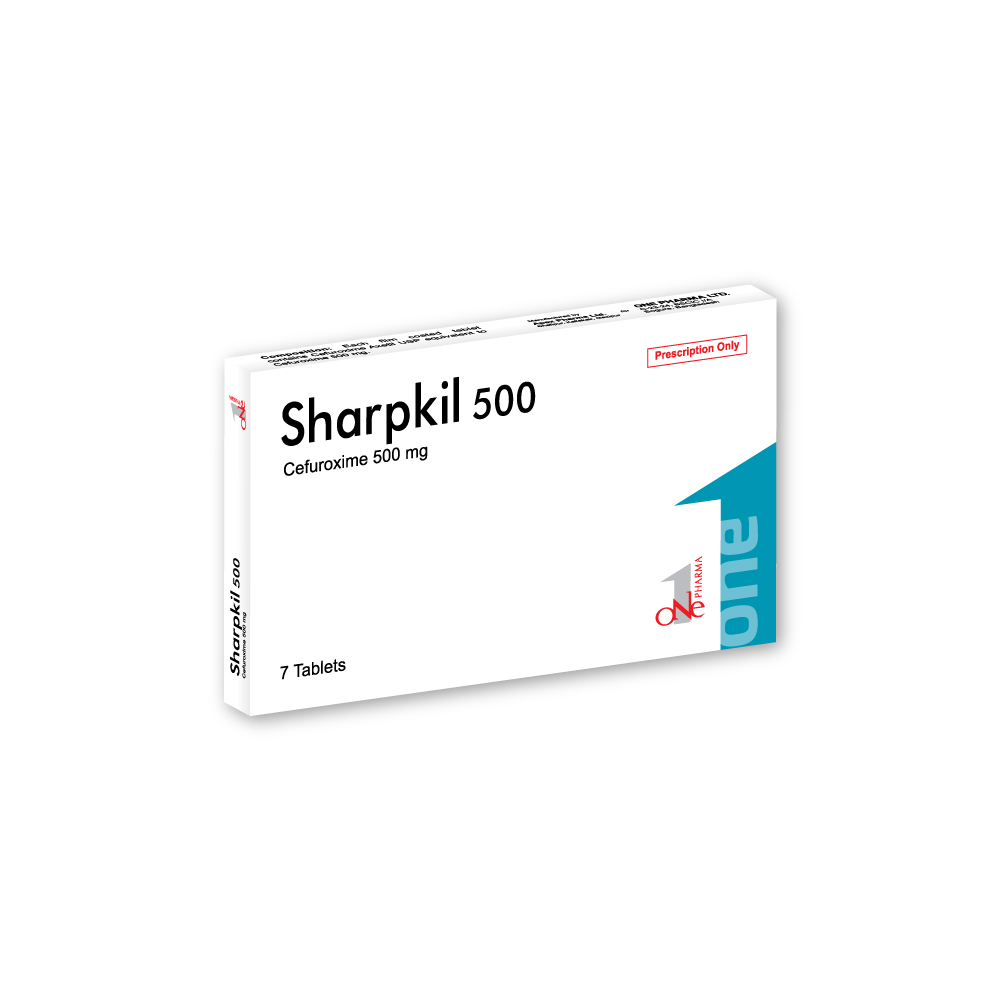





Composition
Sharpkil 250 Tablet: Each film coated tablet contains Cefuroxime Axetil USP equivalent to Cefuroxime 250 mg.
Sharpkil 500 Tablet: Each film coated tablet contains Cefuroxime Axetil USP equivalent to Cefuroxime 500 mg.
Pharmacology
Cefuroxime is one of the bactericidal second generation cephalosporin antibiotics,
which is active against a wide range of Gram-positive and Gram-negative
susceptible organisms including many ß-lactamase producing strains. It is indicated
for the treatment of infections caused by sensitive bacteria.
Indications
Dose and Administration
Route of administration: Oral
Contraindications
Patients with known allergy to cephalosporins & pseudomembranous colitis are contraindicated.
Warning & Precautions
Cefuroxime should be given with care to patients receiving concurrent treatment with
potent diuretics & who have history of colitis.
Side-effects
Common: Generally Cefuroxime and Clavulanic acid are well tolerated. However, a
few side effects like nausea, vomiting, diarrhea, abdominal discomfort or pain may
occur. As with other broad-spectrum antibiotics, prolonged administration of Cefuroxime may result in overgrowth of nonsusceptible microorganisms.
Rare: Renal dysfunction, anaphylaxis, angioedema, pruritis, rash and serum
sickness like urticaria may appear.
Use in Pregnancy & Lactation
During pregnancy: While all antibiotics should be avoided in the first trimester if possible. However, Cefuroxime can be safely used in later pregnancy to treat urinary and other infections.
During lactation: Cefuroxime is excreted into the breast milk in small quantities. However, the possibility of sensitizing the infant should be kept in mind.
Drug Interactions
With Medicine:- Concomitant administration of probenecid with Cefuroxime
increases the area under the serum concentration versus time curve by 50%. Drug
that reduces gastric acidity may result in a lower bioavailability of Cefuroxime and
tend to cancel the effect of postprandial absorption.
With food & other:- Avoid eating grapfruit and drinking grapfruit juice while taking
cefuroxime. Cefuroxime may cause a false-positive reaction for glucose in the urine
with copper reduction.
Overdose
Signs and symptoms: Overdosage of Cefuroxime can cause cerebral irritation leading to convulsions.
Management: Serum levels of Cefuroxime can be reduced by haemodialysis and peritoneal dialysis.
Storage
Store below 30° C temperature. Keep in dry place, away from light. Keep out of reach of children.
Packing
Sharpkil 250 Tablet: Each box contains 7 tablets in 2 Alu-Alu blister pack.
Sharpkil 500 Tablet: Each box contains 7 tablets in 1 Alu-Alu blister pack.
Pharyngitis/tonsillitis caused by Streptococcus pyogenes
Acute bacterial otitis media caused by Streptococcus pneumoniae,
Haemophilus influenzae (including beta lactamase producing strains), Moraxella Catarrhalis (including beta-lactamase producing strains) or Streptococcus pyogenes
Acute bacterial maxillary sinusitis caused by Streptococcus pneumoniae or
Haemophilus influenzae (non-beta-lactamase producing strains only)
Lower respiratory tract infections including pneumoniae, caused by
Streptococcus pneumoniae, Haemophilus influenzae (including beta
lactamase-producing strains), Klebsiella spp., Staphylococcus aureus
(penicillinase and non-penicillinase producing strains), Streptococcus pyogenes, Escherichia coli Acute bacterial exacerbations of chronic bronchitis and secondary bacterial
infections of acute bronchitis caused by Streptococcus penumoniae,
Haemophilus influenzae (beta-lactamase negative strains) or Haemophilus
parainfluenzae (beta-lactamase negative strains)
Skin and Skin-Structure Infections caused by Staphylococcus aureus
(penicillinase- and non-penicillinase-producing strains), Streptococcus
pyogenes, Escherichia coli, Klebsiella spp. and Enterobacter spp.
Urinary tract infections caused by Escherichia coli or Klebsiella pneumoniae
Bone and Joint Infections caused by Staphylococcus aureus (penicillinase and non-penicillinase producing strains)
Gonorrhea: Uncomplicated and disseminated gonococcal infections due to
Neisseria gonorrhoeae (penicillinase and non-penicillinase producing strains) in both males and females
Early Lyme disease (erythema migrans) caused by Borrelia burgdorferi
Septicemia caused by Staphylococcus aureus (penicillinase and
non-penicillinase producing strains), Streptococcus pneumoniae, Escherichia coli, Haemophilus influenzae (including ampicillin-resistant strains), and Klebsiella spp.
Meningitis caused by Streptococcus pneumoniae, Haemophilus influenzae
(including ampicillin resistant strains), Neisseria meningitidis and
Staphylococcus aureus (penicillinase and non-penicillinase producing strains) Switch therapy (injectable to oral) after surgery when patient’s condition is improved
Packing
Sharpkil 250 Tablet: Each box contains 7 tablets in 2 Alu-Alu blister pack.
Sharpkil 500 Tablet: Each box contains 7 tablets in 1 Alu-Alu blister pack.